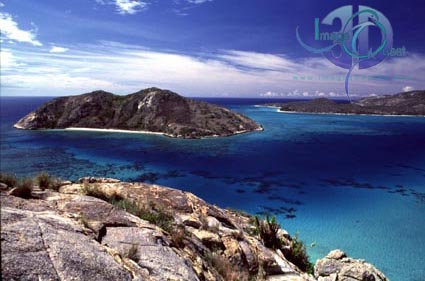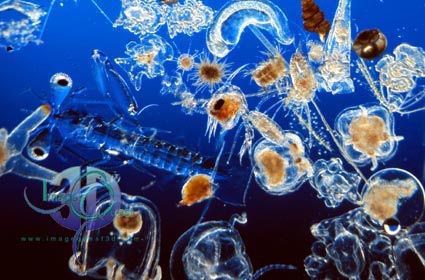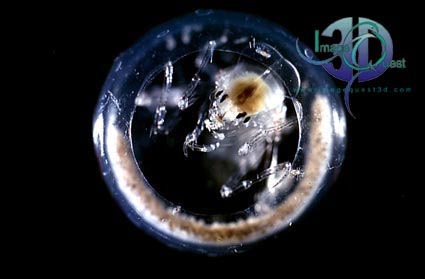|
"A BRIGHT END TO A DULL DAY"

|
|||||||||
|
The wet season in the tropics is often a pretty grey and soggy affair. Underwater, off the coast of Lizard Island at the northern end of the Queensland Great Barrier Reef it is duller and soggier still. The wet season in Queensland follows the cyclone period and both are capable of producing for the diver the best and the worst of conditions. The late southern summer also seems to produce the best swarms of plankton but they are sporadic. Great blocks of drifting organisms come gently swirling into the inner reef waters and slowly pass by Lizard Island sometimes for days at a time. Most go unnoticed. Just once in a while a diver with a sharp eye marvels at their content. Late in our 1983 trip, close to the end of February, three of us set out to dive in Watsons's Bay, named after Watson, who in the last century supplied the large Chinese population with the delicacy of boiled sea cucumbers (beche-de-mer). While Mr. Watson was out on one of his fishing trips, the Island was invaded by Aboriginals who after first killing one Chinese servant tried to kill Mrs. Watson, her baby and her other Chinese servant who launched themselves off that shore in a vessel that was nomally used for boiling the sea cucumbers. Sadly none of them survived. Our dive was designed to find and photograph a beautiful Hyppolytid shrimp that lives commensally in the company of the sticky, rubbery synaptid sea cucumbers that live forty feet down in that particular bay. Our dive commenced through waters that seemed only to hold a few hydromedusae and the odd salp. It was the second half of the afternoon and with the lowering cloud-cover, the light underwater was dingy to say the least. We found our sea cucumbers and the shrimps which accompanied them - grey to the naked eye but brilliant scarlet in the light of the strobes we carried. By about 4 p.m. we were low on exposures, low on air, a bit cold and beginning to think of dry clothes and hot tea. We slowly ascended to the Zodiac above us. As we delayed our journey to look around before surfacing and to remain on the right side of decompression, we became aware of a lot of material in the water. At first it seemed to be mainly gelatenous "houses" of larvaceans, some occupied, some not. But then as our eyes became accustomed to our low-contrast-surroundings, Roger Steene ( of renowned stills fame) and I both let out a grunt at the same moment. We were surfacing through one of the thickest and most diverse plankton swarms either of us had ever experienced. ©
2001 by Image Quest 3-D
Read our copyright notice
We were surrounded by millions of creatures above, below and on every side. Almost everything we could discern was different to the run of the mill species with which we were familiar. Right at the outset a Phronima swam by my face inside its carefully crafted salp test - the contents of which it had eaten. The last time I had seen Phronima was on board R.S. Discovery in the cod-end of a net that had come up from 1000 metres below in the Atlantic! Pram Bug - Phronima ©
2001 by Image Quest 3-D
Read our copyright notice
There followed a strange scene. Three of us were pirouetting about vertical axes each trying to focus no further than the end of our demand valves, eyes crossed, fingers pointing and squeaks of delight coming from each of us in turn as we saw and recognized more and more bizarre creatures. In the middle of this, with tanks now effectively at zero and the light falling fast, Roger and I both spotted the same odd-looking creature at the same time. Fluttering along, two feet below the surface, wide-eyed and glassy-transparent came a 4cm long larval fish. My first impression was of an eel leptocephalus larva or a larval flatfish, but this had none of the mean expression. It was as surprised to see us as we were to see it! On top of its head it sported a couple of little drumsticks. It was then that I knew what we were looking at. This was a late larval stage of the legendary oar fish - a thirty foot giant as an adult. Click here to view the larva in question.... Roger and I twisted and turned to keep the diaphonous creature against the dark background but in the light from above. We were in its company for about a minute and then it was lost to view - not by speed or agility, just superlative sight-defying transparency. We surfaced on our final breaths. Roger always surfaces in a splutter of effusive expression but on this occasion his comments were unprintable. Suffice it to say that we both knew we had seen a little miracle swim by and we were grateful - very grateful.
|



